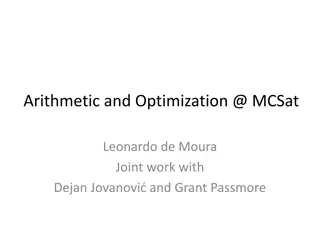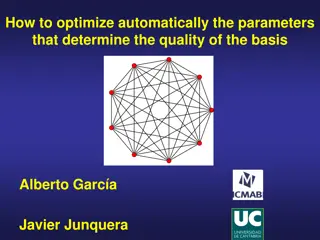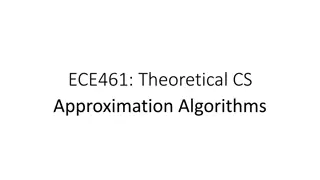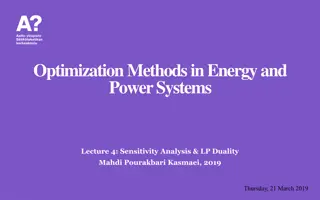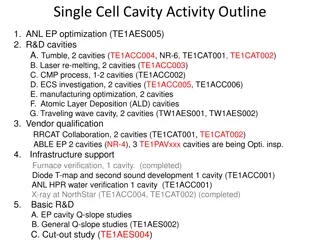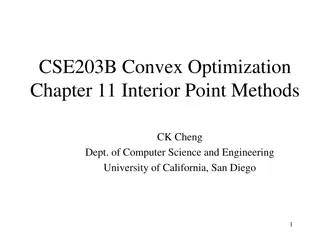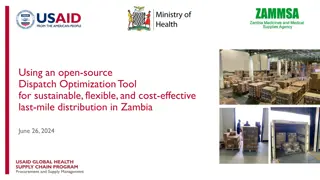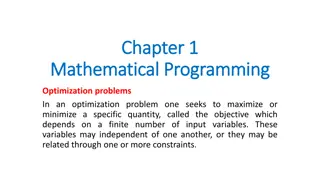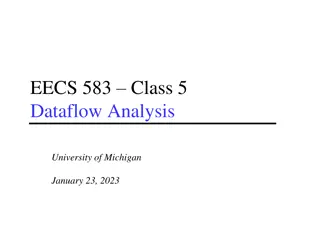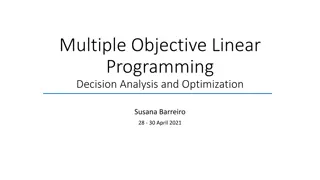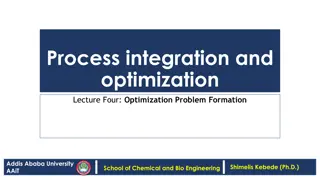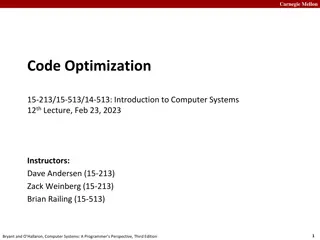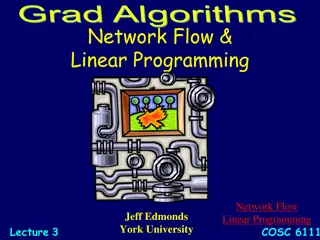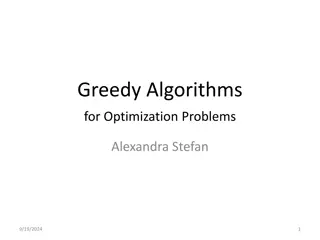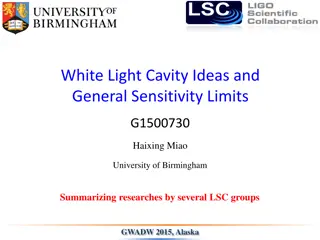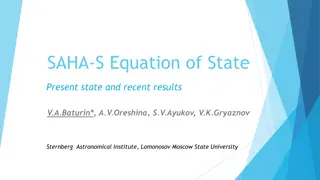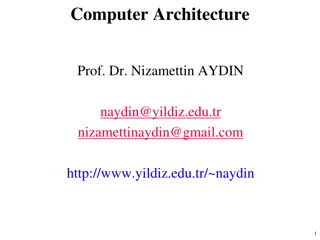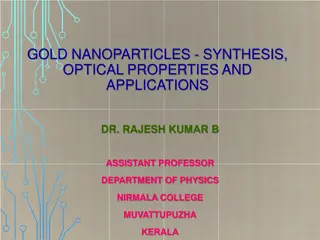SASE Optimization with OCELOT: Recent Advances and Results
OCELOT, along with fellow researchers, has been optimizing SASE at facilities like FLASH, focusing on economic benefits and improved performance. By combining model-free and model-depending optimization techniques, they have achieved significant progress in beam dynamics simulations and tuning sequences, resulting in faster and more effective tuning processes. The team's experience shows that automatic SASE tuning can be achieved in minutes under stable conditions, demonstrating repeatability and efficiency in optimization strategies.
Download Presentation

Please find below an Image/Link to download the presentation.
The content on the website is provided AS IS for your information and personal use only. It may not be sold, licensed, or shared on other websites without obtaining consent from the author. Download presentation by click this link. If you encounter any issues during the download, it is possible that the publisher has removed the file from their server.
E N D
Presentation Transcript
SASE optimization with OCELOT Sergey Tomin other co-workers: I. Agapov, G. Geloni, I. Zagorodnov
Outline Motivation How it works Recent results of empirical tuning at FLASH (model-free optimization) OCELOT features in beam dynamics simulations Extending of empirical tuning by model-depending optimization Summary
Motivation The major motivation is the economic benefit of improving facility availability and performance through more effective and faster tuning
How it works BLM Typical tuning sequence for FLASH: V14, V7, H10, H12, H3, V3 Q13SMATCH, Q14SMATCH, Q15SMATCH FODO QUADS intra-undulator orb. correctors RF phases and Voltages Orbit correctors and FODO quads have largest impact SASE det. corr. 1 Nc quad. 1 Nq sext. 1 Ns Optimizer bend. 1 Nb Cavit. 1 - Ncv Undul. All steps programmed to avoid electron beam losses in the undulators above threshold (solutions above 0.7 alarm level highly penalized and above alarm level forbidden). .
How it works Python script from ocelot.utils.mint.mint import Optimizer, Action, TestInterface from flash1_interface import FLASH1MachineInterface, FLASH1DeviceProperties #from lcls_interface import LCLSMachineInterface, LCLSDeviceProperties dp = FLASH1DeviceProperties() mi = FLASH1MachineInterface() opt = Optimizer(TestInterface(), dp) opt.log_file = 'test.log' opt.timeout = 1.2 seq1 = [Action(func=opt.max_sase, args=[ ['H10SMATCH','H12SMATCH'], 'simplex'] ) ] seq2 = [Action(func=opt.max_sase, args=[ ['V14SMATCH','V7SMATCH'], 'simplex' ] )] seq3 = [Action(func=opt.max_sase, args=[ ['Q13SMATCH','Q15SMATCH'], 'simplex' ] )] opt.eval(seq1) #opt.eval(seq1 + seq2 + seq3 + seq4 + seq5)
Experience of model-free optimization at FLASH Automatic SASE tuning works in a few minutes if the machine is in initially stable condition Demonstrated at several wavelengths (17nm, 13.5nm, 10.4 nm, 7 nm) with different bunch filling at about 0.3 nC charge
Last shift results: SASE optimization by correctors ? = 10.4 ?? For optimization is necessary initial SASE signal To check repeatability of the optimization techniques we repeated the same experiment after resetting correctors to initial values
Last shift results: SASE optimization by correctors ? = 10.4 ?? after resetting correctors
Last shift results: SASE optimization by correctors ? = 10.4 ?? and after correctors cycling
Last shift results: SASE optimization by correctors ? = 10.4 ?? H12SMATCH: I = 0.015 A Extended set of correctors used Was logged all changes what OCELOT optimizer did but without online processing
Last shift results: SASE optimization by correctors ? = 13.4 ?? H3UND4: I = 0.5 A From previous experiments we found most effective correctors and repeated optimization process using them for new machine settings ? = 13.4 ??
Resume The empirical tuning works and was demonstrated at FLASH at several wavelengths (17nm, 13.5nm, 10.4 nm, 7 nm) with different bunch filling at about 0.3 nC charge The method was demonstrated at SLAC (mainly uses quadrupoles in the linac. This tuning procedure they called Ocelot optimization ) Do not exist universally effective sequence of operations for fast SASE tuning (it is necessary to control the optimization from operator s side). Stability of the machine operation is necessary. From our experience in ~10-15% cases SASE fluctuations were great and the method does not work. Scalability for XFEL needs to be studied. The optimization is model-free.
Ocelot overview Twiss parameters calculation (CPBD module) Particle tracking (CPBD module) Matching module (CPBD module) Orbit correction module (was implemented for Siberia-2 Light Source at 2013 see Tomin et al., proc. IPAC 2013) (CPBD module) Native module for spontaneous radiation calculation SASE calculations using GENESIS Native module for photon ray tracing Python based Open source https://github.com/iagapov/ocelot OCELOT was designed with on-line capability in mind (see Agapov et al., NIM A. 768 2014) Developed infrastructure for switching between flight simulator/controls mode with binding to DOOCS and EPICS. Already used for on-line beam control at Siberia-2 and for SASE tuning at FLASH and SLAC.
Developing Charge Particle Beam Dynamics (CPBD) module in OCELOT. added second order matrices. added space charge solver (@ M.Dohlus and I.Zagorodnov) FLASH, Q = 1 nC ??,? ?
Cross-checking with Elegant: Tracking including second order matrices ??cross-checking ??cross-checking
Cross-checking with Elegant: Current profile at the Start point
Cross-checking with Elegant: Current profile at the End point Using second order matrices
Cross-checking with Elegant: Beam distribution in space ? ? ? at the Start point of FLASH
Cross-checking with Elegant: Beam distribution in space ? ? ? at the End point of FLASH
Future plans of development CPBD module Add CSR effect in cooperation with DESY Add wakefield effects in cooperation with DESY Testing and further development symplectic tracking Further development of matching module
Extending of empirical tuning by model-depending optimization Creation of realistic model of accelerator Visualization of changes during Ocelot optimization. Orbit steering Algorithm of strategy selection Online model ?
Visualization of changes during Ocelot optimization Using converter tpi2k() (@Mathias Vogt) can be calculated relative changes in beam trajectory and in optical functions X/Y, m S, m
Visualization of changes during Ocelot optimization Using converter tpi2k() (@Mathias Vogt) can be calculated relative changes in beam trajectory and in optical functions (?) X/Y, m S, m It can give idea that problem was in horizontal direction
Orbit steering Changing orbit in some point of the lattice to maximize SASE level.
Algorithm of strategy selection BLM algorithm of strategy selection (statistical analysis) SASE det. corr. 1 Nc quad. 1 Nq sext. 1 Ns Data Base of successful optimizations Optimizer bend. 1 Nb Cavit. 1 - Ncv Undul. Online module (orbit steering) BPM 1 Nb
Online model of accelerator ? Used last optics file (MAD8 and Elegant) Taken the amplitudes and phases of cavities from control system by PyDoocs Taken quadrupoles currents from the control system and using tpi2k we got the strengths And we got these beta functions
Reading real orbit and fitting beam trajectory Horizontal plane
Reading real orbit and fitting beam trajectory Vertical plane
Reading real orbit and fitting beam trajectory Quadrupole misalignments m Creation of realistic and online model is not simple task. Number of quads
Summary On-line control python tools have been developed Demonstrated automatic SASE tuning at FLASH and SLAC Proposal for further FLASH beamtime to study more advanced tuning methods has been approved and further developments are ongoing Implementation of GUI for FLASH/XFEL in progress (~02.2016) Planning of further steps wrt. XFEL.EU is underway. The first step of optimization tool implementation can be beam transmission tuning during commissioning. R&D into more complex tuning methods are needed. Even the simplest empirical tuning methods would bring significant advantage for facility availability.












